There is something called the “7 wonders of the ancient world” and we are about to tell you about it!
If you look around you, you will see that there are many amazing things the modern world has to show you; things that are capable of dropping your jaw in pure wonder and awe. Indeed the super-beautiful creations of technology have surely left us all asking the inevitable question, “how?”
We wonder how people were able to sit down and come up with such impossible ideas to create incredibly charming things that we can now use every day. From the airplanes we see flying up above us and the intricate network we now know as the internet, to the advancement of space technology leading to space travel, the human race has come a really long way since its inception and we are still growing.
Indeed, all around us are wonderful creations that elicit wonder and awe, including robots that can mimic animals, but do you know that long before all these wonderful creations of technology came about, men of old have created absolutely breathtaking things that caused a lot of buzz in their day and even in ours? You may not know it, buy yes, long before our day, men with a powerful drive so tall as the Mount Everest embarked on great journeys to create things that generations unborn would come to marvel at.
The beauty of all ancient creative masterpieces has come to be known as “The 7 wonders of the ancient world”.
The seven wonders of the ancient world refer to the list of incredibly amazing works of art and architecture over a period of time from the 1st-2nd century BC which have come to serve as an undeniable testament to the immeasurable ingenuity and deep imagination of the human being coupled with sheer hard work which are capable of bringing to life previously impossible things.
READ ALSO: 9 Most Surprising Things You Won’t Believe Exist In Outer Space
These ancient wonders of the ancient world include Great Pyramid of Giza, The Colossus of Rhodes, the Lighthouse of Alexandria, the Mausoleum at Halicarnassus, the Temple of Artemis, the Statue of Zeus and the Hanging Gardens. Let’s take a look at them.
The Great Pyramid Of Giza

The great pyramid of Giza has stunned the human race for its utter magnificence and great size. People have wondered over the years how the builders managed to put together such a massive structure.
Like its name implies, the Pyramid of Giza is located in Giza, Egypt and it was constructed for the Egyptian Pharaoh Khufu between 2584 and 2561 BCE. History has it that this pyramid remained the tallest man-made structure for as many as 4,000 years. Incredible!
The most impressive thing about the pyramid is that it covers a massive 13 acres and contains more than 2 million stone blocks. Impossible, right? Well, we’re not done yet; those stone blocks are said to weigh from 2 to 30 tons each. Phew!
The Hanging Gardens Of Babylon
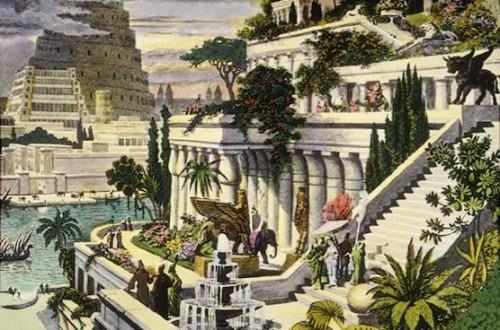
Now, this is something that has defied human logic since its tale was told. The hanging gardens of Babylon are even considered to be a myth because they have never been located.
Scholars believe that the hanging gardens of Babylon were built around 600 BC. They were built by the great King Nebuchadnezzar II for his wife and is generally thought to be a beauty that must have stunned Babylonians back then.
The hanging gardens are said to have consisted of beautiful garden structures with ascending tiered gardens which looked like a large green mountain.
Scholars reveal that the gardens were planted 75 feet in the air. Massive! This made the gardens hang on a huge square brick terrace that was said to have been laid out in steps just like what you find in a theatre.
The Statue Of Zeus At Olympia
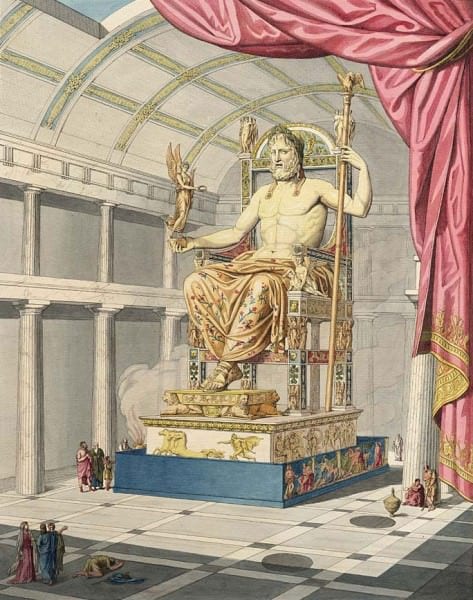
The statue of Zeus is one of the most famed statues in the world. The statue was built around 435 BC by the famous sculptor Phidias. In the ancient Greek religion, Zeus is the god of the sky and thunder. The statue was built to honor the thunder god; depicted him sitting on his throne.
The statue was really large. In fact, scholars believe that it stood 43 feet tall and was sculpted with ivory and gold panels.
The Temple Of Artemis At Ephesus

This is one structure which was so awe-inspiring that all the writers who wrote about it spoke with pure wonder. According to scholars, the temple of Artemis At Ephesus took as long as 120 years to build.
The structure which was sponsored by the wealthy King Croesus of Lydia, was completed in 550 BCE. The temple stood at a massive 425 feet.
Sadly, it was destroyed 356 BC. History has it that it was destroyed on July 21, 356 BCE by a man named as Herostratus who set fire to it.
Herostratus reportedly revealed that he set fire to the temple so that he can achieve lasting fame by forever named as the man who destroyed something as beautiful as the structure.
The Mausoleum At Halicarnassus
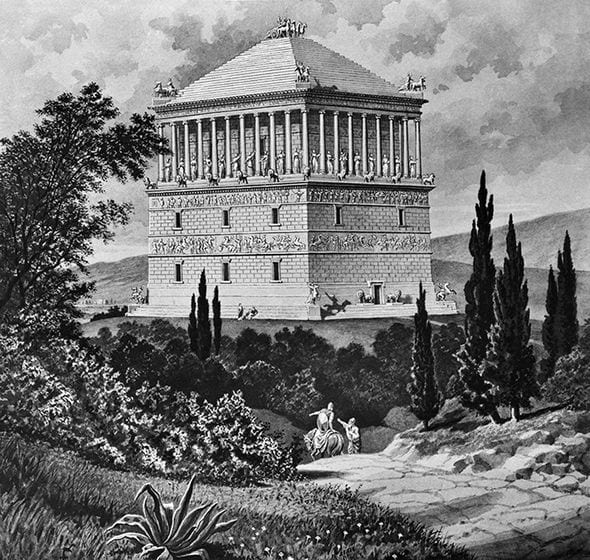
The Mausoleum at Halicarnassus which was located near modern-day Bodrum is a wonder that was built between 353 BC and 350 BC.
The great masterpiece was built by Artemisia for her husband, Mausolus, the king of Carnia in Asia Minor, who died in 353 B.C. The Queen wanted to create a completely magnificent final resting place that was worthy of such a great king hence she went to great length to build the mausoleum.
Sadly she died two years later and her ashes were also placed in the tomb.
The Colossus Of Rhodes
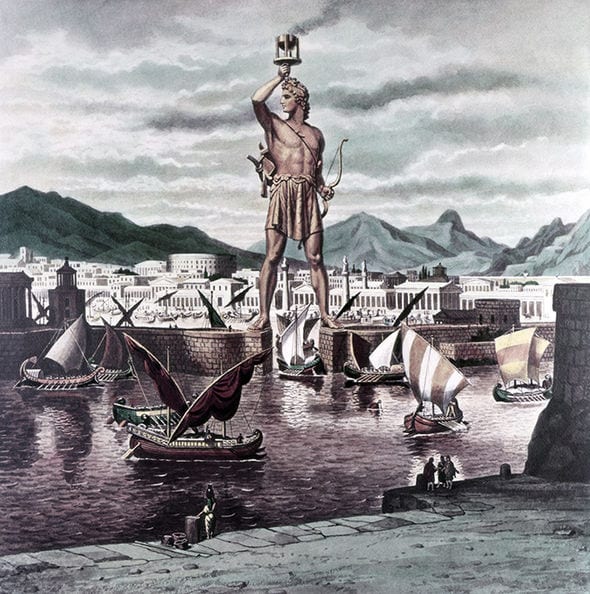
The Colossus is a really enormous statue that was built to honor Helios, the sun god in Greek mythology. It was built in 280 BC.
Scholars reveal that the Colossus was created by the Rhodians to celebrate the victory over Cyprus. The massive structure stood at 108 feet high which happen to be the same height as the Statue of Liberty. This means that the Colossus was the tallest of the 7 wonders.
It was sadly destroyed in 226 BC by an earthquake and was never rebuilt.
Lighthouse Of Alexandria
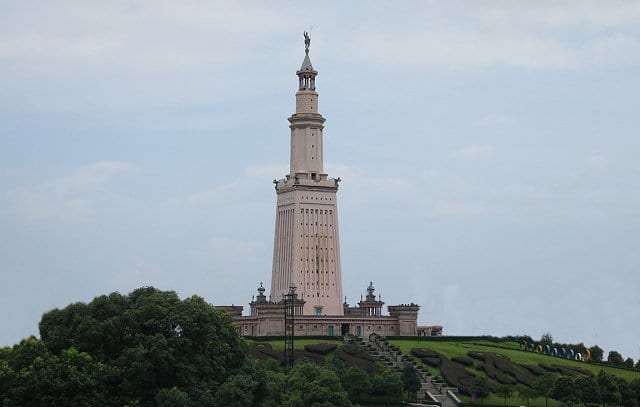
The Lighthouse of Alexandria is sometimes called the Pharos of Alexandria. The incredible structure massively stood close to 440 feet (134 m) in height and was built on the island of Pharos in Egypt which would be later known as Alexandria.
The structure was commissioned by Ptolemy I Soter even though work on the building was set in motion by Alexander The Great. Ptolemi I took over the work after Alexander’s death and the construction was completed sometime around 280 BCE.
Scholars, while describing the beautiful structure, say the Lighthouse rose from a square base on the ground and formed a middle octagonal section before moving up to achieve a circular top. In fact, those who reportedly saw the structure in its awesome glory revealed that words were inadequate to describe its stunning beauty.
The building was however sadly damaged in a massive earthquake in 956 BC.














